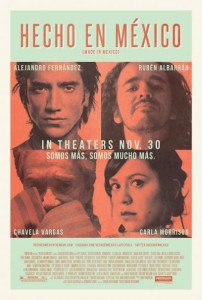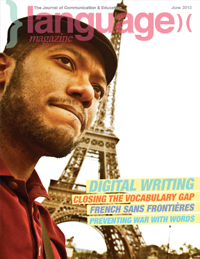Alex Rappaport argues that word acquisition may be the easiest way to close the achievement gap
One promise of public education is to level the playing field across the socioeconomic and ethnic spectrum. Unfortunately, the system is not fulfilling that promise. The achievement gap has been an issue for decades, and it’s getting worse.
A recent study released by Stanford University sociologist Sean F. Reardon shows that the gap has widened by 40% since the 1960s. The study looked at the disparity in academic achievement between students in the tenth percentile of family income against students in the ninetieth percentile. Standardized test scores were used as a metric, which is fairly common in achievement gap studies. Other metrics include high school dropout rates and college graduation rates. Unfortunately, the relationship between income and achievement is consistent across all of these metrics. According to Teach for America, only 8% of students growing up in poverty graduate from college by age 24, compared with 80% of students in more affluent areas. In other words, the effects of the gap extend beyond test scores and make a significant impact on achievement throughout a student’s academic career.
Many researchers attribute the lower achievement to “opportunity gaps” such as a lack of educational resources at home, limited access to health-care, and even more subtle factors like test bias, stereotyping, and peer pressure. With so many social and cultural factors at play, the problem can seem insurmountable. What to fix first? And how? Elimination of poverty or improvements to the health care system can’t be achieved from within the classroom walls.
But according to Eric D. Hirsch, a prominent researcher and literary critic, the socioeconomic achievement gap is in part a vocabulary gap. Research suggests that greater vocabulary knowledge leads to higher test scores. This presents an approachable and actionable solution: by investing in more direct vocabulary instruction within academic settings, we can compensate for economic disadvantages and make strides towards closing the gap. Progress can be made if we focus on the vocabulary gap.
The Case for Direct Vocabulary Instruction
Why is the socioeconomic achievement gap in part a vocabulary gap? State reading tests are a key benchmark of success in our education system. These tests primarily measure reading comprehension, and one of the most fundamental aspects of reading comprehension is being able to recognize and infer meaning from vocabulary.
We can now start to make an argument for the direct correlation between vocabulary knowledge and test scores. Dr. Roger Farr, a former president of the International Reading Association and prominent author and researcher, has said that, “reading comprehension is 63% vocabulary.” (Full disclosure: in 2008, Flocabulary hired Dr. Farr’s research firm to design an instructional validation study for our vocabulary program.) Dr. Farr goes so far as to say, “The size of a student’s vocabulary is the single best predictor of success on state tests.”
Here’s the problem. Not all students are getting direct vocabulary instruction in school, and when we rely on the home for vocabulary acquisition, low-income students find themselves at a distinct disadvantage. According to Hirsch, by second grade, a child in the middle of the family income spectrum will know, on average, 6,020 words. A child in the bottom 25% of the income range will know just 4,168 words. This gap is caused in part by a lack of exposure to adult conversation in low-income households. These adults often work two or three jobs, which limits opportunities for reading stories at bedtime or having discussions around the dinner table. A 1995 study by Betty Hart and Todd Risley showed that, in a typical hour, the average child in a welfare home will hear only 616 words. A child in the average professional home will hear 2,153 words. This disparity creates a significant testing disadvantage for the low-income child.
Strategies for Direct Vocabulary Instruction
To make up for this disparity in vocabulary knowledge, we need to invest in more direct vocabulary instruction during school hours. Many academic programs rely solely on conversation and reading to teach vocabulary, but experts like Isabel Beck and Margaret McKeown emphasize the importance of explicitly exposing students to vocabulary in a wide range of contexts and settings.
When it comes to exposures, variety and repetition are key. In Flocabulary’s Word Up vocabulary program, we utilize eight varied exposures in our lesson sequence. These include traditional exposures like reading passages and use in a sentence, but what makes Word Up so successful is the use of creative exposures in engaging contexts. Our use of educational rap songs takes advantage of two of the most tried-and-true mnemonic devices in human history: music and rhyme. Some of the best teachers use music and chants to teach new material, and students find this presentation engaging and accessible.
While music and rhyme are excellent, there are other strategies that can be used to teach a new word. Three simple and effective options are pronunciation (saying the word aloud), charades (acting the word out), and writing (using the word in context).
Pronunciation may seem trivial, but it has a positive physical implication; saying a word actually imprints it on the muscles of the ear and jaw. This is known as kinesthetic learning and should not be overlooked. Beyond muscle memory, saying a word in your own voice can be a first step toward making it your own.
Charades is a powerful strategy because it encourages students to think abstractly about a word and its meaning. For example, in the case of the word “vain,” a student would need to think about what a vain person would do in order to act it out. Maybe that means pantomiming a mirror and gazing into it. Charades is a way of learning the word by being the word, and many reading experts agree that dramatic context is one of the best ways to make vocabulary stick.
Last, but possibly most important, is writing. It’s that pedagogical gold standard that has been a central tenet of everything from Bloom’s Taxonomy to the Common Core State Standards. The writing process calls upon higher-order thinking skills and helps a student transition from being a consumer of information to a producer. This is also known as generative processing and is thought to be a key step in the progression toward word ownership and mastery. Unfortunately, many students dislike writing, so using engaging strategies can be very helpful. One approach is to have students write academic rhymes using a targeted word list. This makes the writing fun and incorporates those great mnemonic techniques.
The key to effective vocabulary instruction is to get creative and find ways to bring words to life. The use of interactive mini-games can be used with word lists to do so.
Breaking Vocabulary Down
Beyond teaching with effective strategies, it’s also important that we’re teaching the right words. Once again, we look to guidance from Beck and McKeown, who have grouped vocabulary into three tiers. According to their system, Tier I words are basic scaffolding words that are often learned through conversation and don’t require much explicit instruction. These are common nouns and verbs like chair, boy, and run. Tier II words are interdisciplinary bridge words that appear across the academic curriculum and can show up in many contexts. These are words like subordinate, abundant, and precious. Tier III words are subject-specific terms that are generally used in only one context and have one meaning. Good examples are hypotenuse, amoeba, and isthmus.
Reading passages on state tests are generally populated by Tier II vocabulary, and these are also the words that students are most likely to encounter in reading assignments across the academic curriculum. Teaching Tier II words prepares students for standardized reading tests.
With this in mind, it is important for teachers to generate Tier II word lists to study and also identify Tier II words that are encountered in reading assignments. One criterion for identifying a Tier II word is determining that the word has multiple uses or applications. A word like precious is a perfect example. A precious gem might be studied in geology, while the concept of something precious could be found in a poem or novel. The goal is to isolate these difficult Tier II words and take time to explicitly teach them using a variety of strategies.
As income disparity continues to grow, the socioeconomic achievement gap will continue to be an issue. While changes in social and education policies will help over time, an emphasis on direct vocabulary instruction is something tangible that we can implement right away. The Common Core State Standards, with their deliberate emphasis on vocabulary in varied contexts, are an encouraging step toward acknowledging the value of vocabulary proficiency, and the national discussion around the importance of vocabulary across the curriculum is beginning to feel like a groundswell. This momentum, coupled with an ever-growing body of supporting research, should be more than enough to motivate us to make a greater investment in explicit vocabulary instruction and take an actionable step toward closing the achievement gap.
References
Reardon, Sean F. “The widening academic achievement gap between the rich and the poor: New evidence and possible explanations” in R. Murnane & G. Duncan (Eds.), Whither Opportunity? Rising Inequality and the Uncertain Life Chances of Low-Income Children, New York: Russell Sage Foundation Press, 2011
Beck, McKeown and Kucan, Bringing Words to Life: Robust Vocabulary Instruction, Guilford Press, New York, 2002
Alex Rappaport is the co-founder and CEO of Flocabulary, a web-based learning tool that uses educational hip-hop music to teach students in grades K-12. Learn more at www.flocabulary.com.
 Sponsored by the Mexican Tourist Board in Los Angeles and Aeromexico, the event will feature musical performances by artists from the film, a conversation with the film’s director Duncan Bridgeman, and the screening of this inspiring movie that showcases the cultural and artistic diversity of the world’s largest Spanish-speaking country.
Sponsored by the Mexican Tourist Board in Los Angeles and Aeromexico, the event will feature musical performances by artists from the film, a conversation with the film’s director Duncan Bridgeman, and the screening of this inspiring movie that showcases the cultural and artistic diversity of the world’s largest Spanish-speaking country.







 Moscow’s Renaissance Moscow Olympic Hotel offers a unique opportunity to learn Russian and become closer to the Russian culture.
Moscow’s Renaissance Moscow Olympic Hotel offers a unique opportunity to learn Russian and become closer to the Russian culture.